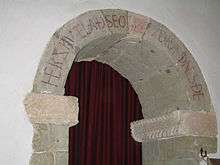Wynn
Wynn or wyn[1] (Ƿ ƿ) (also spelled wen, ƿynn, or ƿen) is a letter of the Old English alphabet, where it is used to represent the sound /w/.
| Ƿ | |
|---|---|
| Ƿ ƿ | |
| (See below) | |
 | |
| Usage | |
| Writing system | Latin script |
| Type | Alphabetic and Logographic |
| Language of origin | Old English language |
| Phonetic usage | [w] /wɪn/ |
| Unicode value | U+01F7, U+01BF |
| History | |
| Development | ᚹ
|
| Time period | ~700 to ~1100 |
| Descendants | Ꝩ ꝩ |
| Sisters | None |
| Transliteration equivalents | w |
| Variations | (See below) |
| Other | |
| Other letters commonly used with | w |
| Name | Proto-Germanic | Old English |
|---|---|---|
| *Wunjō | Wynn | |
| "joy" | ||
| Shape | Elder Futhark | Futhorc |
| Unicode | ᚹ U+16B9 | |
| Transliteration | w | |
| Transcription | w | |
| IPA | [w] | |
| Position in rune-row | 8 | |

History
The letter "W"
While the earliest Old English texts represent this phoneme with the digraph ⟨uu⟩, scribes soon borrowed the rune wynn ᚹ for this purpose. It remained a standard letter throughout the Anglo-Saxon era, eventually falling out of use (perhaps under the influence of French orthography) during the Middle English period, circa 1300.[2] It was replaced with ⟨uu⟩ once again, from which the modern <w> developed.
Meaning
The denotation of the rune is "joy, bliss" known from the Anglo-Saxon Rune Poems:[3]
- ᚹ Ƿenne bruceþ, þe can ƿeana lyt
sares and sorge and him sylfa hæf
blæd and blysse and eac byrga geniht. [Lines 22-24 in The Anglo-Saxon Runic Poem]
- Who uses it knows no pain,
- sorrow nor anxiety, and he himself has
- prosperity and bliss, and also enough shelter. [Translation slightly modified from Dickins (1915)]
Miscellaneous
It is not continued in the Younger Futhark, but in the Gothic alphabet, the letter 𐍅 w is called winja, allowing a Proto-Germanic reconstruction of the rune's name as *wunjô "joy".
It is one of the two runes (along with þ) to have been borrowed into the English alphabet (or any extension of the Latin alphabet). A modified version of the letter wynn called vend was used briefly in Old Norse for the sounds /u/, /v/, and /w/.
As with þ, the letter wynn was revived in modern times for the printing of Old English texts, but since the early 20th century the usual practice has been to substitute the modern ⟨w⟩.
Wynn in Unicode and HTML Entities

- U+01F7 Ƿ LATIN CAPITAL LETTER WYNN (HTML
Ƿ) - U+01BF ƿ LATIN LETTER WYNN (HTML
ƿ) - U+16B9 ᚹ RUNIC LETTER WUNJO WYNN W (HTML
ᚹ) - U+A768 Ꝩ LATIN CAPITAL LETTER VEND (HTML
Ꝩ) - U+A769 ꝩ LATIN SMALL LETTER VEND (HTML
ꝩ) - "Unicode character search". Retrieved 2012-04-28.
References
- "wyn". Oxford English Dictionary (3rd ed.). Oxford University Press. September 2005. (Subscription or UK public library membership required.)
- Freeborn, Dennis (1992). From Old English to Standard English. London: MacMillan. p. 25. ISBN 9780776604695.
- Dickins, Bruce (1915). Runic and Heroic Poems of the Old Teutonic Peoples. Cambridge: Cambridge University Press. p. 14-15.